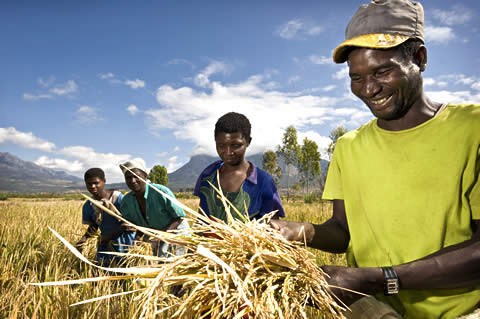

The Rice Mill which was inaugurated on Friday has a capacity to process 15 metric tonnes per day.

Represented by the Commissioner for Agriculture, governor Ortom asked the processors and the IFAD programme managers to package rice with premium quality that can compete in the market.
The IFAD project coordinator, Mr Samuel Eremie, expressed satisfaction with the response from the participating farmers who have been able to build houses, and other properties they could not afford prior to the IFAD value chain development programme.
While commissioning the mill, the representative of governor Ortom conveys’ his message on the need to uphold a standard in the processing value chain.
Also commissioned, is the IFAD VCDP cluster farm road project, linking the various cooperative farms.
The participants also expressed worry over the insecurity challenges and adequate land clearing which was later addressed.
It was further stated that the state may likely recover from the threats of the food crisis, an imminent aftermath of the ongoing herdsmen attacks.


The warning follows an alert by regional food security experts that “erratic rainfall, high temperatures and persistent Fall Army Worm infestation are likely to have far-reaching consequences on access to adequate food and nutrition” over the next 12-15 months.
The alert, by officials from the 14-nation Southern African Development Community (SADC), the Famine Early Warning Systems Network (FEWSNET), UN agencies and non-governmental organisations (NGOs), listed Botswana, Malawi, Mozambique, Zimbabwe, Madagascar, Zambia and South Africa as the worst-affected countries.
The dry spell, which started in October, has caused crops to wilt. Pasture has also suffered, threatening the survival of livestock herds.
Even if there is above-average rainfall over coming months, much of the damage to crops is irreversible.
“Given that the region has barely emerged from three years of very damaging El Niño -induced drought, this is a particularly cruel blow”, says Brian Bogart, WFP’s Regional Programme Advisor. “But it shows how important it is to address the root causes of hunger and malnutrition in the face of changing climatic conditions”.
There are now fears for another rise in the number of people in the region needing emergency food and nutrition assistance – this fell from a peak of 40 million during the 2014-2016 El Niño crisis to 26 million last year.
The humanitarian community is now working with governments, SADC and other partners to assess the extent of the damage and its likely impact on those most at risk in the region.
What is the Main Cause of a Heart Attack? What is its Solution? A heart attack is the blockage of… Read More
In the vast economic arena, one term that often takes center stage, inciting extensive debates and discussions, is the "debt… Read More
De-Dollarization: The Changing Face of Global Finance The financial landscape is in a state of flux, with an intriguing economic… Read More
The curtains closed on a dramatic Bundesliga season with Bayern Munich standing tall once again, clinching their 11th straight title.… Read More
The Unfolding Story of Celine Dion's Health In recent news that has left fans across the globe stunned, iconic singer… Read More
As the echoes of the recent NBA season start to fade, the attention of enthusiasts is firmly glued to one… Read More